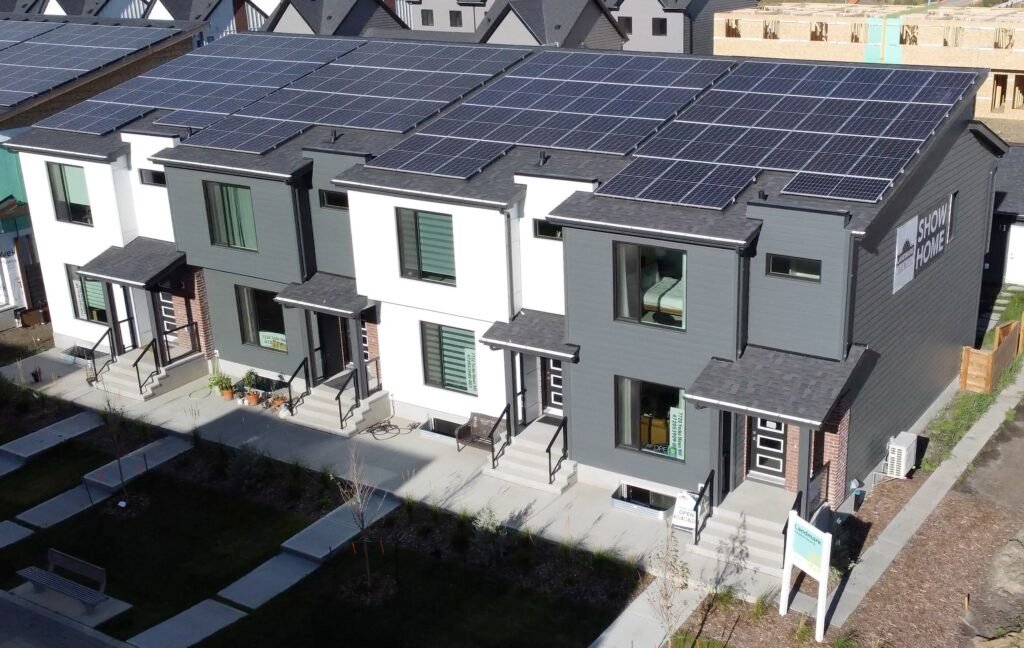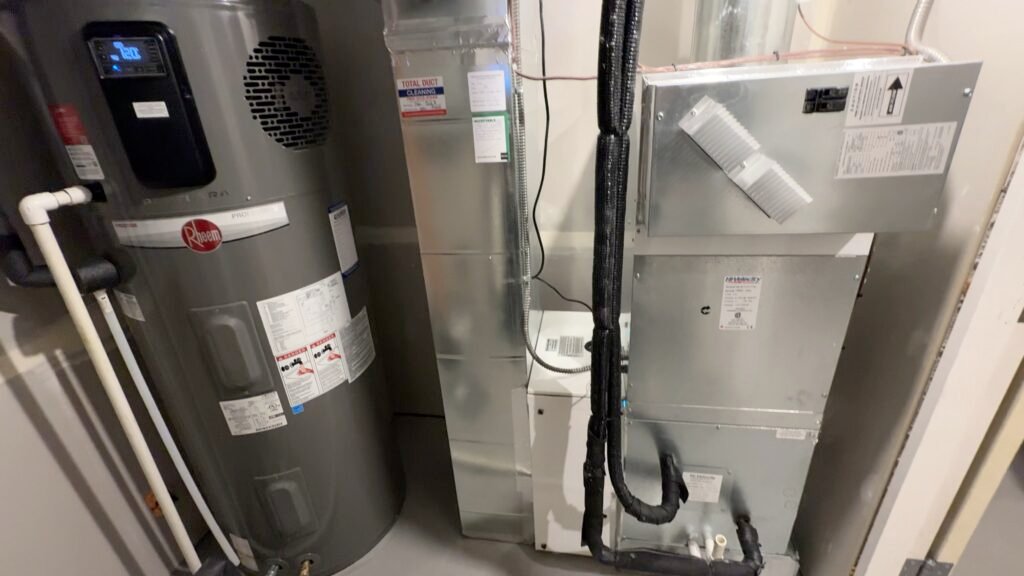Blatchford Carbon Neutral Community – Part 4
Table of Contents
By David Dodge, GreenEnergyFutures.ca
Landmark, a net-zero trailblazer in Alberta, has joined the Blatchford family in constructing their unique brand of energy-efficient, solar-powered, net-zero homes in Blatchford that produce almost no utility costs.
“Blatchford is the biggest planned carbon-neutral community in all of Canada. And this perfectly matches Landmark’s values and those of our founder, who’s been committed to net zero for about 16 years,” says Micah Dueck of Landmark Homes.
Blatchford has a strict green building code that demands homes to meet a high standard, but Landmark is going above and beyond to build fully net-zero homes using their unique formula, which they’ve honed over the past decade and a half.
And that’s exactly what first-time homebuyers Kassandra Starkell and Martin Martyniak were seeking in a new home.
“We were looking to buy our first home. We wanted to stay relatively central in Edmonton. And once we found the Blatchford neighborhood, it just clicked,” says Starkell.
“In terms of the ‘Blatchfordness’ of it, we really liked the energy efficiency that came with the homes, especially the Landmark home,” she says.
The young couple didn’t want to think about any future upgrades; they wanted the whole package right from the start. And since the Landmark homes exceeded the green building code and came with solar, and an air-source heat pump their home would be net-zero from day one.

Landmark’s secret sauce – utility bill not included
Landmark Homes doesn’t have a natural gas connection or a gas bill. Thanks to their 9-10 kilowatts of solar, they generate all the electricity and heating they need, and their utility bills are almost non-existent.
One of the main reasons for this is the air-source heat pump.
“When heating the home, it’s about a 300% gain in efficiency. When cooling the home, it’s close to a 700% gain in efficiency, which is otherworldly,” says Dueck.


The High-Velocity air-source heat pumps in these homes are different from the ground-source heat pumps most homes here use. They don’t come with a utility bill.
The only energy bill owners of these homes receive is for electricity, and there’s enough solar to cover the entire bill. So, to be clear, there’s a good chance they won’t pay anything for energy on average.
The air-source heat pump can handle temperatures as low as -30 Celsius and has a built-in electric heater as a backup, which they won’t need often because the heat pump is so efficient, and the home is so energy-efficient.
And of course, these homes have a heat recovery ventilator (HRV) that captures 82% of the heat in waste air, triple-paned windows, and an energy-efficient heat pump water heater.

Downtown living – green space included
Kassandra and Martin wanted to reside in the heart of the city while still having easy access to all the amenities they cherish. This includes a convenient short hop into downtown, enjoyable bike rides in the community, and the convenient option of biking to work.
Kassandra eagerly anticipates the expansion of cycling infrastructure outside their neighborhood to connect with the existing community facilities already in place.
Nearly everyone we spoke to was very surprised by the abundance of green space in this downtown neighbourhood.
A short walk from Kassandra’s home is a lake with wildlife, walking trails, a playground, and even a community garden.
Kassandra says their pedestrian-only front street, Yorke Mews, was a key selling point.
Dueck explains that the neighbourhood lacks front-facing garages, opting instead for patios or small decks. This contributes to the community’s sense of belonging and togetherness.
Kassandra appreciates the community space, where they can encounter neighbours, see children playing, and enjoy the absence of traffic in front of their home.

Location, Location, Location
Planners may have been rightfully wary of building pedestrian-only streets in Blatchford, not knowing how they would be accepted. But perhaps ironically, this is one of the things Kassandra and many of her neighbours mentioned as a big selling feature. There is only one block of pedestrian-only street in Blatchford so far.
This new brand of urban design seems to be gaining acceptance among consumers.
“I think that’s born from a passion for city living, being central, having access to the LRT, being very close to the office, reducing travel time, and things of that nature,” says Dueck.
“There is just a lot of romance here, and I think you’d have to experience it yourself to fully understand what I’m trying to communicate to you.”
“I think it really comes down to location, amenities, and the infrastructure that’s gone into the development of the community,” says Dueck.
The neighbourhood has a mall, large grocery stores, a hospital, coffee shops and even a brewery nearby, things you will either wait decades for or never have in the suburbs.
“It’s just a very, very well-thought-out community.”

Batteries Included
If it wasn’t enough that these homes are solar-powered and net-zero, Landmark is also installing a 20-kilowatt-hour battery energy storage system in all of their homes in Blatchford.
In a partnership with Emissions Reduction Alberta, the batteries are being installed as part of a pilot project that seeks to explore the benefits of storing surplus solar energy during the day and using it at night.

The idea of the pilot is to interconnect all the batteries in the homes in a virtual power plant that could offer valuable peaking power to the grid, if and when policies allow this.
“Net-zero breaks even, you know, it doesn’t cost you anything for energy, but with the batteries, you actually make extra money,” says Nasseri.
The batteries are installed and some of the details of how the virtual power plant might work are still being worked out.
Robots and the quest for efficiency
Landmark’s founder is Reza Nasseri, an engineer with a passion for efficiency. The other secret sauce Landmark uses if offsite construction using robots and automated machinery imported from Germany about 15 years ago.
In the ACQBuilt Edmonton plant a 3D model of the home is created, then the computer helps order exactly the right lumber from the mill, and robots cut, nail, and trim the walls with extraordinary precision down to a single millimetre.
“You save a lot of time, and time is very costly,” says Nasseri. “The benefit is that you build them very fast, and the most important part is that a house built that way saves around 75% of material waste.”
Landmark also uses engineered lumber that is much stronger than regular 2x4s and also very straight. We saw perfectly straight 40-foot-long 2x4s in the plant when we toured it with Haitao Yu of Landmar,k who has a PhD in building science.
Building air-tight energy energy-efficient homes in a plant with robots
Take a tour of the ARQBuilt Plant in photos. Landmark Homes are built in the ARQBuilt Plant in Edmonton which uses custom-ordered lumber, robots and conventional labour to build air-tight homes in a controlled environment that produces very little waste.
The resulting walls are very square, which helps make for a very tight, super-sealed home.
For workers, there are no -30C days. Workers build homes inside the warm plant year-round and safely shingle the roofs just a few feet off the floor as the roof trusses sit on the floor of the factory.
The roof and walls are then loaded on a truck and are taken to the home site, and a crane lifts the walls and roof into place. Nasseri says it takes about one day to build the home components in the factory and another day to install it once the basement is poured and ready onsite.

Consumers are getting wise to the value of net-zero
Landmark started building net-zero homes so long ago that it was ahead of the curve, and consumers didn’t fully appreciate the incredible value of a home that requires very little energy and produces all of its own energy.
It’s music to the ears of Reza Nasseri when sees a young couple buying their first home as a net-zero home and clearly understanding the value of it.
Landmark built the most affordable net-zero home in Canada in 2017. At $399,000 including GST it was a two-storey home in the suburbs with a garage that was fully net-zero.
“Our goal as, as a builder is to produce the most sustainable, efficient homes at the lowest possible cost. And this is the first community that has been focused on that same goal,” says Dueck.
For 16 years Nasseri and his team have been pouring over the spreadsheets to find the most cost-effective way to build net-zero homes and today they are some of the highest quality homes money can buy and as Dueck says, the company has found the perfect place for these homes in Blatchford and a new generation of home buyers wise to the value of the homes.
Watch for future episodes in our Blatchford Carbon Neutral Community series and be sure to subscribe the the series on YouTube or to our CKUA.com Radio podcast.











